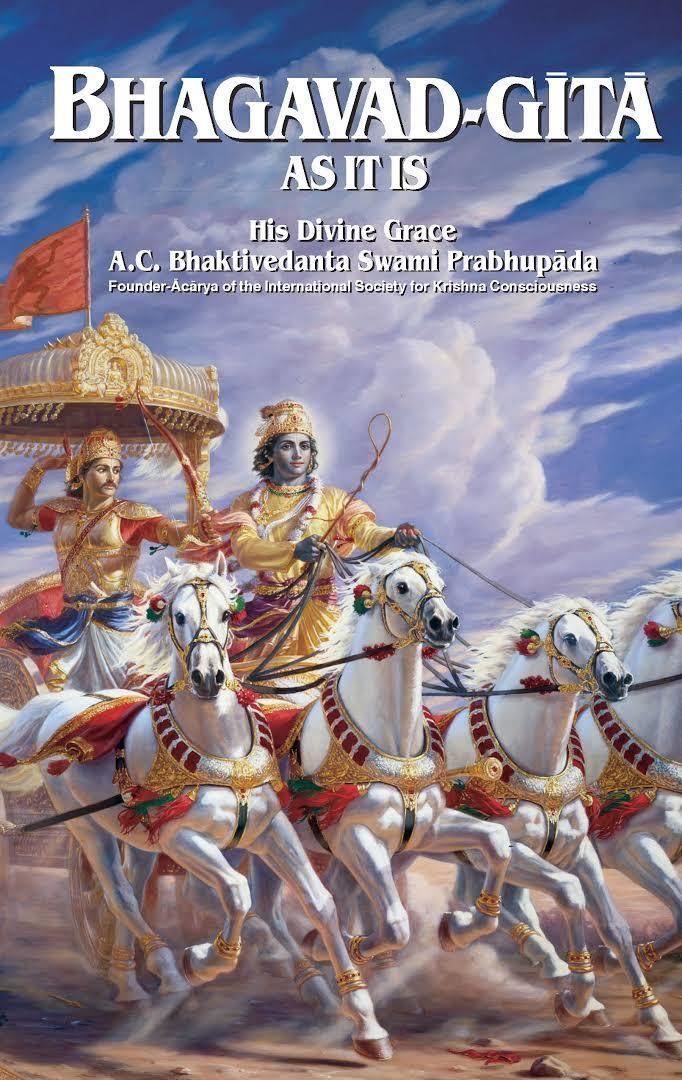8.2 /10 1 Votes
Originally published 1968 | 4.1/5 Goodreads | |||||||||||||||||||||||||||||||||
 | ||||||||||||||||||||||||||||||||||
Similar A C Bhaktivedanta Swami Prabhupada books, Hinduism books | ||||||||||||||||||||||||||||||||||
Bhagavad-Gītā As It Is is a version of the holy Hindu text, Bhagavad Gita, that contains a translation and commentary by A.C. Bhaktivedanta Swami Prabhupada, founder of the International Society for Krishna Consciousness (ISKCON), commonly known as the Hare Krishna movement. The Bhagavad Gita emphasizes a path of devotion toward the personal God, Krishna. It was first published in 1968 by Macmillan Publishers and is now available in nearly sixty languages and is primarily promoted and distributed by followers of the Hare Krishna movement.
Contents
Contents
For each verse, the book (in complete editions) includes the Devanagari script, a Latin transliteration, word-for-word Sanskrit-English meanings, and English translation. An extensive commentary by Prabhupada is given throughout, based on various Gaudiya Vaishnava works, including: Ramanuja Bhasya (in Sanskrit); Sarartha-varsini-tika (Sanskrit) by Visvanatha Chakravarti Thakura; Gita-bhusana-tika (Sanskrit) by Baladeva Vidyabhushana; and Bhaktivinode Thakur's Bengali commentaries.
Thus the book advocates the path of bhakti toward Krishna, who is seen as the Supreme Personality of Godhead Himself. It establishes that Krishna is not an incarnation, He is the cause of all causes. He is the source of all incarnations. He is even the cause of Vishnu. It teaches the loving service of the transcendental personality of the Lord.
The Bhagavad Gita As It Is by Prabhupada has been praised by scholars and theologians for providing the Western reader the unique opportunity of seeing how a Krishna devotee interprets his own texts and for giving insights into the original and highly convincing ideas of the Gauḍiya Vaisnava school.
Bhagavad-Gītā As It Is is written in the tradition of Gaudiya Vaishnavism. Followers of the Vedas regard the Bhagavad Gita as the essence of the Vedic knowledge and the Upanishads and consider the book authoritative and literally true.
Some abridged editions of the Gita come with prefaces by Allen Ginsberg and Thomas Merton. The 1972 Macmillan "Complete Edition" includes a Foreword by Professor Edward C. Dimock, Jr. from the University of Chicago.
Edition History
A.C. Bhaktivedanta Swami Prabhupada, the author, arrived in the United States in 1965. By 1966 he had founded the International Society for Krishna Consciousness (ISKCON) in a storefront at 26 2nd. Ave New York City. At that time he was very anxious to publish his Bhagavad-gita As It Is. Macmillan Publishers agreed to publish a 400-page version in 1968 but the original manuscript was over 1000 pages. So the first Macmillan edition was known as the Abridged Edition.
By 1972 the sales of the Abridged edition were substantial and Macmillan agreed to publish the "Complete Edition".
In 1983, the Bhaktivedanta Book Trust (BBT) published the "Revised and Enlarged" edition containing at least one thousand substantial changes. The changes were justified as being 'closer to the original manuscript'. This 'Revised and Enlarged' edition has been very controversial among the followers of Srila Prabhupada. In 2001 Krishna Books Inc (KBI) who are licensed by the BBT reprinted the 1972 "Complete Edition" so now both the "Complete Edition" and the "Revised and Enlarged" edition are available.
Distribution
This translation is probably the one most sold outside India, due to the efforts of Hare Krishna members on the streets, in airports, and in other public places. The book also enjoys brisk sales within India. It has been published in fifty-nine languages, including French, German, Spanish, Dutch, Portuguese, Italian, Swedish, Russian, Polish, Czech, Slovak, Latvian, Ukrainian, Macedonian, Bulgarian, Hungarian, Georgian, Croatian, Chinese, Japanese, Arabic, Hebrew, Persian, Nepali, Hindi, Bengali, Gujarati, Kannada, Malayalam, Odia, Tamil, and Telugu.
Varnashrama dharma
Socially, Bhagavad-Gītā As It Is suggests a way of life derived from the Manu Smriti and other books of Hindu religious and social law and applied for the contemporary Western world. In this way of life, ideal human society is described as being divided into four Varnas (brahmana - intellectuals, kshatriya - administrators, vaishya – merchants, shudra - workers). Within his writings Prabhupada supports the view that one becomes a member of one of the Varnas not by birth but by one's personal qualities (guna) and the type of work (karma) one actually performs (BG 4.13). Society is described as best ruled by a benevolent kshatriya sovereign, who is to govern according to rules set by scriptural tradition and preserved by self-controlled and pure-hearted spiritual leaders (brahmanas). The kshatriya sovereign (like courts in many democratic states) may also order capital punishment.
Brahmanas, elders, women, children and cows are said to deserve special protection, with animals, especially cows, being preserved from slaughter at all costs. Prabhupada encourages readers to adopt a lacto-vegetarian diet and gives agriculture as the ideal economic basis of society. Ultimately Prabhupada gives the conclusion that society should be "Krishna conscious"—enlightened by devotion (bhakti) to Krishna (God).
Trial
In June 2011, a group linked to the Christian Orthodox Church had demanded a ban owing to an alleged "conflict of interests" between the Russian followers of Krishna and local authorities in the Siberian region of Tomsk. The case was dismissed by a federal judge on 28 December 2011.
Russian ambassador Alexander M. Kadakin condemned the "madmen" seeking the ban, underlining that Russia was a secular country:
15,000 Indians in Moscow, and followers of ISKCON in Russia asked the Indian government to intervene to resolve the issue. The move triggered strong protests by Members of Parliament as they wanted the Indian Government to take up the matter strongly with Russia. The final hearing in the Tomsk district court was then scheduled on 28 December, with the court agreeing to seek the opinion of the Russian Ombudsman on human rights in the Tomsk region as well as Indologists from Moscow and St Petersburg. The prosecutor's office filed an appeal against the judge's ruling, but on March 21, 2012, the appeal court upheld the decision of the lower court, rejecting the prosecutor's petition.
